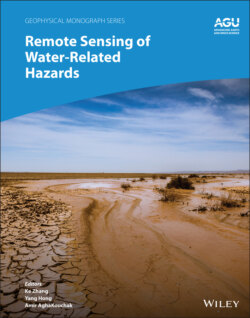Читать книгу Remote Sensing of Water-Related Hazards - Группа авторов - Страница 17
Part II: Remote Sensing of Floods and Associated Hazards
ОглавлениеAs one of the deadliest natural hazards in the world, floods have historically received a great deal of attention in the remote sensing community. In chapter 4, Zhang et al. integrate remote sensing, hydrological‐hydraulic modeling, and Geographic Information System (GIS) techniques to map inundation and quantify flood hazard risks. Their approach allows for filling the information and knowledge gap in data scarce regions. More specifically they combine a two‐dimensional coupled hydrology‐inundation model with satellite remote sensing data from the Moderate Resolution Imaging Spectroradiometer (MODIS) and the Phased Array Type L‐band Synthetic Aperture Radar‐2 onboard the Advanced Land Observing Satellite‐2 (ALOS‐2 ALOS2/PALSAR‐2) to map flood hazards and their impacts in Nyaungdon Area, Myanmar.
In chapter 5, Chen et al. use a case study of remote sensing of floods triggered by Hurricane Harvey in Houston, Texas, USA. This chapter investigates the detectability of extreme rainfall through multisensor remote sensing and the simulation performance of the induced flooding via multidimensional modeling. It introduces a multidimensional modeling framework based on the Coupled Routing and Excess Storage (CREST) model family, designed to utilize multisensor remote sensing products for hydrologic applications. The chapter demonstrates that the integration of multisensor remote sensing precipitation and multidimensional modeling has a high potential to provide accurate and timely flood warning of the extreme events in a changing climate.
Hydrological modeling is a key tool for flood forecasting and early warning. Remote sensing datasets have allowed not only better parameterization of hydrological models but have also moved toward large‐scale, near‐real‐time flood/inundation forecasting. However, configuring and executing stand‐alone hydrologic models can be difficult, especially in regions with a lack of high‐level modeling and data analysis expertise. In chapter 6, Wan et al. present a new web‐accessible lumped hydrological modeling framework for researchers and practitioners to facilitate the organization of hydrological data, execution of hydrologic models, and analysis of results. The chapter shows how the efficiency of data processing and query can be improved through adopting the Hadoop Distributed File System (HDFS) and the Apache Hive concept. The authors integrate the lumped CREST and Hydrological Model (HyMOD) as a proof of concept in this framework.
Rainfall‐triggered landslides are often associated with extreme precipitation events and floods, causing significant loss of life and property. Understanding the interactions between flood/rainfall events and landslides is fundamental to improve current landslide monitoring and prediction models. In chapter 7, Zhang et al. develop a coupled flood and landslide disaster early warning system for operational use by coupling two distributed hydrologic models, the Coupled Routing and Excess Storage (CREST) model and the Sacramento Soil Moisture Accounting (SAC‐SMA) model, with two physically based landslide prediction models, the Slope‐Infiltration‐Distributed Equilibrium (SLIDE) model and the Transient Rainfall Infiltration and Grid‐Based Regional Slope‐Stability (TRIGRS) model. The Bayesian Model Averaging method is then applied to average the outputs of the ensemble members to produce an integrated outcome. This ensemble‐based framework allows quantifying the uncertainty of the predictions and the probability distributions of anticipated events, enhancing disaster preparedness and prevention.
Advances in sensor technology make high‐resolution SAR imagery data with a spatial resolution as fine as 0.3 meters available for distinguishing manmade objects in urban areas, such as bridges, roads, and drainage systems. In chapter 8, Liu et al. present an investigation to understand the backscattering characteristics of bridges over water using TerraSAR‐X satellite images and Pi‐SAR2 airborne images. The difference and correlation coefficient of the backscattering intensity between the SAR images before and after the hazard events were calculated to detect potential flood damages. Using both SAR and aerial photos, they demonstrate that high‐resolution SAR images can provide a valuable and effective way to accurately detect collapsed bridges caused by extreme events.
